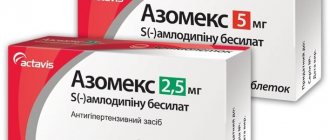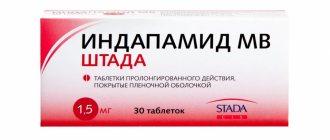Cordaflex® RD
Pharmacokinetic interactions
Medicines that affect the metabolism of nifedipine
Nifedipine is metabolized by CYP3A4/5 isoenzymes, which are located in the intestinal mucosa and liver. Drugs that inhibit or induce this enzyme system may affect the first pass effect through the liver (after oral administration) or the clearance of nifedipine.
Inducers of the CYP3A4 isoenzyme
Rifampicin
Rifampin is a potent inducer of the CYP3A4 isoenzyme. When used simultaneously with rifampicin, the bioavailability of nifedipine is significantly reduced and, accordingly, its effectiveness is reduced. Therefore, the simultaneous use of nifedipine with rifampicin is contraindicated.
Antiepileptic drugs that induce CYP3A4 (eg, phenytoin, carbamazepine, phenobarbital)
Phenytoin induces the CYP3A4 isoenzyme. With the simultaneous use of nifedipine and phenytoin, the bioavailability of nifedipine is reduced and its effectiveness is reduced. When using this combination simultaneously, it is necessary to monitor the clinical response to nifedipine therapy and, if necessary, increase its dose. If the dose of nifedipine is increased with simultaneous use of both drugs, the dose of nifedipine should be reduced after discontinuation of phenytoin. Clinical studies examining the potential interaction between nifedipine and carbamazepine or phenobarbital have not been conducted. Since both drugs reduce the concentration of nimodipine in the blood plasma, which is structurally similar to BMCC, the possibility of a decrease in the concentration of nifedipine in the blood plasma and a decrease in its effectiveness cannot be excluded.
CYP3A4 isoenzyme inhibitors
Macrolide antibiotics (for example, erythromycin)
Clinical studies on the interaction of nifedipine and macrolide antibiotics have not been conducted. Some macrolides are known to inhibit the CYP3A4 isoenzyme. As a result, the possibility of an increase in the concentration of nifedipine in the blood plasma cannot be excluded with the simultaneous use of nifedipine and macrolide antibiotics.
Azithromycin, a macrolide antibiotic, does not inhibit the CYP3A4 isoenzyme.
HIV protease inhibitors (eg, ritonavir)
Clinical studies examining the interaction of nifedipine and HIV protease inhibitors have not been conducted. It is known that drugs of this class inhibit the CYP3A4 isoenzyme. In addition, drugs of this class have been shown to suppress the metabolism of nifedipine mediated by the CYP3A4 isoenzyme in vitro.
When used simultaneously with nifedipine, a significant increase in the concentration of nifedipine in the blood plasma cannot be ruled out due to a decrease in the effect of “first pass” through the liver and slower elimination.
Azole antifungals (eg, ketoconazole)
Clinical studies examining the interaction of nifedipine and azole antifungals have not been conducted. It is known that drugs of this class inhibit the CYP3A4 isoenzyme. When used simultaneously with nifedipine, a significant increase in the systemic bioavailability of nifedipine is possible by reducing the effect of “first pass” through the liver.
Cimetidine and ranitidine
It has been established that cimetidine and ranitidine inhibit the CYP3A4 isoenzyme and cause an increase in the concentration of nifedipine in the blood plasma (by 80% and 70%, respectively), thereby enhancing its antihypertensive effect.
Diltiazem
Diltiazem reduces the clearance of nifedipine. This combination should be used with caution. A dose reduction of nifedipine may be required.
Fluoxetia
Clinical studies examining the interaction of nifedipine and fluoxetine have not been conducted. It is known that fluoxetine in vitro
suppresses the metabolism of nifedipine mediated by the action of the CYP3A4 isoenzyme. Therefore, the possibility of an increase in the concentration of nifedipine in the blood plasma cannot be excluded with the simultaneous use of nifedipine and fluoxetine.
Nefazodone
Clinical studies examining the interaction between nifedipine and nefazodone have not been conducted. Nefazodone is known to inhibit the metabolism of other drugs mediated by the CYP3A4 isoenzyme. Therefore, the possibility of an increase in the concentration of nifedipine in the blood plasma cannot be excluded with the simultaneous use of nifedipine and nefazodone.
Quinidine
Increased plasma concentrations of nifedipine have been reported when administered concomitantly with quinidine. Therefore, when using quinidine and nifedipine simultaneously, careful monitoring of blood pressure is necessary. If necessary, the dose of nifedipine should be reduced.
Quinupristin/dalfopristin
Concomitant use of quinupristin/dalfopristin may lead to increased plasma concentrations of nifedipine.
Valproic acid
Clinical studies examining the interaction of nifedipine and valproic acid have not been conducted. Since valproic acid increases the concentration of nimodipine in the blood plasma, which is structurally similar to BMCC, the possibility of increasing the concentration of nifedipine in the blood plasma and enhancing its effectiveness cannot be excluded.
Grapefruit juice
Grapefruit juice inhibits the CYP3A4 isoenzyme and suppresses the metabolism of nifedipine. The simultaneous use of nifedipine with grapefruit juice leads to an increase in the concentration of nifedipine in the blood plasma and a prolongation of its action due to a decrease in the effect of “primary passage” through the liver and a decrease in clearance. This may enhance the antihypertensive effect of nifedipine. With regular consumption of grapefruit juice, this effect can last for 3 days after the last consumption of the juice. The consumption of grapefruit/grapefruit juice during treatment with nifedipine is contraindicated (see section Contraindications).
CYP3A4 isoenzyme substrates
Substrates of the CYP3A4 isoenzyme (for example, cisapride, tacrolimus, benzodiazepines, imipramine, propafenone, terfenadine, warfarin), when used simultaneously with nifedipine, may act as CYP3A4 inhibitors and increase the concentration of nifedipine in the blood plasma.
Cisapride
Concomitant use of cisapride and nifedipine may lead to increased plasma concentrations of nifedipine.
Effect of nifedipine on other drugs
Quinidine
Nifedipine causes a decrease in the concentration of quinidine in the blood plasma. After discontinuation of nifedipine, a sharp increase in the concentration of quinidine in the blood plasma may occur. Therefore, when using nifedipine as additional therapy or discontinuing nifedipine, the concentration of quinidine in the blood plasma should be monitored and, if necessary, its dose should be adjusted.
Digoxin
The simultaneous use of nifedipine and digoxin may lead to a decrease in the clearance of digoxin and, consequently, to an increase in the concentration of digoxin in the blood plasma. The patient should be carefully monitored for symptoms of glycoside overdose and, if necessary, reduce the dose of digoxin, taking into account its concentration in the blood plasma.
Theophylline
Nifedipine increases plasma concentrations of theophylline, and therefore the concentration of theophylline in blood plasma should be monitored. The clinical effect of both drugs when used together does not change.
Tacrolimus
Tacrolimus is metabolized with the participation of the CYP3A4 isoenzyme. Recently published data indicate the possibility of increased tacrolimus concentrations in selected cases when administered concomitantly with nifedipine. When using tacrolimus and nifedipine simultaneously, the concentration of tacrolimus in the blood plasma should be monitored and, if necessary, its dose should be reduced.
Vincristine
Nifedipine slows down the elimination of vincristine from the body and may cause increased side effects of vincristine. If simultaneous use is necessary, reduce the dose of vincristine.
Drugs that bind to blood proteins
Nifedipine can displace drugs characterized by a high degree of binding from protein binding (including indirect anticoagulants - coumarin and indanedione derivatives, anticonvulsants, non-steroidal anti-inflammatory drugs (NSAIDs), quinine, salicylates, sulfinpyrazone), as a result of which their concentration may increase in blood plasma.
Cephalosporins
With the simultaneous administration of cephalosporins (for example, cefixime) and nifedipine in probands, the bioavailability of the cephalosporin increased by 70%.
Pharmacodynamic interactions
Medicines that lower blood pressure
The antihypertensive effect of nifedipine may be enhanced when used simultaneously with antihypertensive drugs, such as diuretics, beta-blockers, angiotensin-converting enzyme (ACE) inhibitors, angiotensin II receptor antagonists (ARA II), other BMCCs, alpha-blockers, phosphodiesterase-5 inhibitors, methyldopa.
When using nifedipine and beta-blockers simultaneously, it is necessary to carefully monitor the patient's condition, since in some cases the course of CHF may worsen.
The severity of the decrease in blood pressure increases with the simultaneous use of inhalational anesthetics and tricyclic antidepressants.
Nitrates
When used simultaneously with nitrates, tachycardia increases.
Antiarrhythmic drugs
BMCCs can enhance the negative inotropic effect of antiarrhythmic drugs such as amiodarone and quinidine. Nifedipine should be co-administered with disopyramide and flecainide with caution due to a possible increase in negative inotropic effect.
Magnesium sulfate
It is necessary to carefully monitor blood pressure in pregnant women while using nifedipine with intravenous magnesium sulfate due to the possibility of an excessive decrease in blood pressure, which is dangerous for both the mother and the fetus.
Fentanyl
The simultaneous use of nifedipine and fentanyl can lead to severe arterial hypotension. If possible, it is recommended that nifedipine be discontinued at least 36 hours before fentanyl-based anesthesia.
Calcium preparations
Reduced effectiveness of nifedipine.
NSAIDs
NSAIDs reduce the antihypertensive effect of nifedipine due to suppression of prostaglandin synthesis, sodium and fluid retention in the body.
Sympathomimetics
Sympathomimetics reduce the antihypertensive effect of nifedipine.
Estrogens
Estrogens reduce the antihypertensive effect of nifedipine due to fluid retention in the body.
Lithium preparations
When BMCC is used together with lithium drugs, it is possible to increase the manifestation of the neurotoxicity of the latter (nausea, vomiting, diarrhea, ataxia, tremor, tinnitus).
Cordaflex, 60 pcs., 20 mg, extended-release film-coated tablets
Inside.
Film-coated tablets, 10 mg
should be swallowed whole before meals, without chewing, with a small amount of water.
The dosage regimen is set individually, depending on the severity of the disease and the patient’s response to the therapy. The initial dose is 1 tablet. (10 mg) 3 times a day. If necessary, the dose can be increased to 2 tablets. (20 mg) - 1-2 times a day. At least 2 hours should pass between two doses of the drug. The maximum daily dose is 40 mg.
If it is necessary to increase the dose to 80–120 mg for the treatment of angina pectoris or arterial hypertension, it is recommended to transfer the patient to Cordaflex® extended-release film-coated tablets, 20 mg.
To speed up the action of the drug at the beginning of an attack of angina or hypertensive crisis, the tablet should be chewed, held in the mouth for some time, and then swallowed with a small amount of water.
In elderly patients, the pharmacokinetics of nifedipine changes, and therefore lower doses may be required to maintain sufficient therapeutic effect.
If renal or hepatic function decreases, it is recommended to use with caution the same doses as for normal renal or hepatic function (tolerance may develop). If there is a significant decrease in liver function, it is not recommended to take a dose of more than 40 mg per day.
Extended-release film-coated tablets, 20 mg
should be swallowed whole, without chewing, with a small amount of water.
The recommended starting dose is 1 tablet. 2 times a day (2 × 20 mg). If necessary, the daily dose can be increased up to 2 times 2 tablets. The maximum daily dose of nifedipine should not exceed 120 mg. It is recommended to divide the daily dose into 2 doses at 12-hour intervals.
In patients with impaired liver function, the drug is used with caution under the monitoring of liver function; in case of severe impairment of liver function, the dose must be reduced. In patients with impaired renal function, no dose adjustment is required.
In elderly patients, the metabolism of nifedipine during the initial passage through the liver is reduced, and there is also a higher likelihood of deterioration of cerebral blood flow due to possible sharp peripheral vasodilation, therefore, at the beginning of treatment, the dose of Cordaflex® is reduced by approximately 2 times.
The drug should be discontinued gradually, especially after taking high doses.

